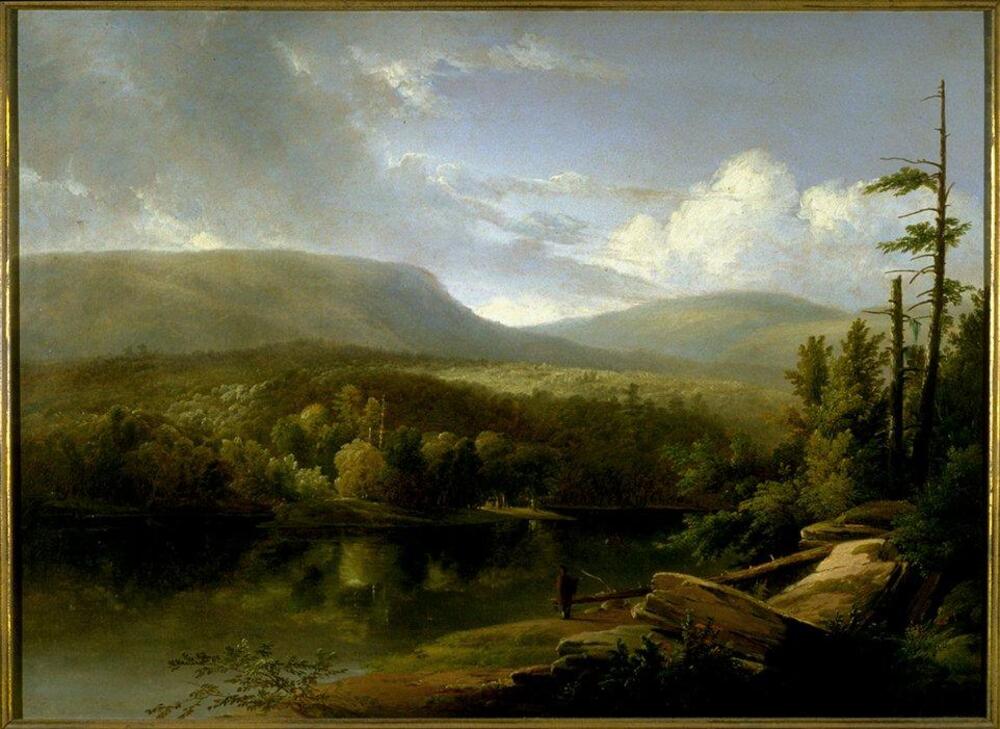Essay: Hart
The Hudson River School operated during the middle of the nineteenth century in and around New York City. Though the name “Hudson River School” was most likely not applied to the group until the 1870s, the members had already defined themselves as a distinctive unit around 1825. The school did not paint exclusively in the New York metropolitan area; as is evident in Hart’s work, they worked up and down the Catskills and even in the Adirondacks in search of glimpses of divinity in nature. These painters, the foundation of the school, used their paintings as a way to make young America appear as if it were a modern-day Eden.
It was as a result of westward expansion and the American mantra of Manifest Destiny that American landscape painting became the dominant genre in the mid- to late-nineteenth century. With the annexation of Texas in 1845, Oregon in 1846, and the end of the Mexican-American War in 1848, the self-consuming desire to expand augmented. But this philosophy did not consider the ethical implications of stealing land from indigenous peoples who had lived there for thousands of years.
Hart’s Adirondacks exemplifies many of the ideals upheld by the Hudson River School. The planar composition is carefully organized and easily accessible to the viewer. The scene is framed by the horizontal fallen log and the vertical trees. The middle ground, which includes the water and the shrubbery that grows along its edge, is both literally and figuratively a reflection on the beauty of nature. It also serves as a peaceful place for the viewer to focus his or her eye. Finally, the mountains and clouds that roll along in the background provide a pleasant, yet distant, cap on the entire scene.
Hart’s delicate hand has rendered brushstrokes practically invisible in this piece. The focus is not on the technique, but instead on the purity and beauty of the subject matter. The style is clearly hyperrealistic: the viewer can imagine the feeling of touching the clouds. Also notable is the focus on the effect of light. This differentiates the work from the European artistic conventions that were prominent at the time.
The dead tree in the foreground is a common convention in many Hudson River paintings. The blasted trunk might represent destruction in the Edenic scene, functioning as a memento mori. The solitary figure overlooking the water is an indigenous person, whose way of life has been disrupted by early settlers in the Hudson River Valley.
Artist
William M. Hart was born in 1823 in Kilmarnock, Ayreshire, Scotland. At eighteen, he came to the United States with his family, including his younger brother James, who also became a landscape painter. They grew up in upstate New York in Albany. Hart began his career in the arts as a designer, painting the curtains and interiors of wealthy citizens’ carriages for the Eaton and Gilbert Company coachmakers in Troy, New York, a position that may have had an influence on his later work as a landscape artist. His job was to create scenery that would accompany travelers on their journeys along the roads of upstate New York.
In his late teens, Hart began working in portraiture, earning five dollars for each painting he made. By 1845, he had exhausted his fondness of painting likenesses and returned to landscapes. Like many Hudson River School painters, he examined the environment with a keen eye and attention to detail. Hart was a member of numerous prestigious institutions like the Brooklyn Academy of Design and the Society Painters in Watercolors. He was clearly a member of the establishment.
Hart exemplified his time’s propensity to look to the land as a reflection of the American spirit an ideal. What this failed to acknowledge however was the rights and humanity of the indigenous people who already were living there.
Themes and Ideas for Teaching
What details of The Adirondacks might indicate the excitement of Westward Expansion and Manifest Destiny? How does the painting emit a feeling of energetic nationalism?
As an institution, the Hudson River School was both celebrated and criticized for its idealized depictions of the United States. Keeping in mind that this was one of the first “American” movements, what might this say about the role of the arts during America’s formative years?
Sources
Andrus, Lisa Fellows “Design and Measurement in Luminist Art.” In American Light: The Luminist Movement 1850 – 1875, Paintings, Drawings, Photographs, edited by John Wilmerding, 31 – 56. Washington, D.C.: National Gallery of Art, 1980.
Avery, Kevin J. “A Historiography of the Hudson River School.” In American Paradise: The World of the Hudson River School edited by John K. Howat, 3 – 20. New York, New York: The Metropolitan Museum of Art, 1987.
Burke, Doreen Bolger & Voorsanger, Catherine Hoover “The Hudson River School in Eclipse.” In American Paradise: The World of the Hudson River School edited by John K. Howat, 71 – 89. New York, New York: The Metropolitan Museum of Art, 1987.
Driscoll, John. All That is Glorious Around Us: Paintings from the Hudson River School. Ithaca, New York: Cornell University Press, 1997.
Kelly, Franklin. “Hudson River School” Grove Art Online. Oxford University Press, 14 February 2008, http://www.groveart.com.
Novak, Barbara “On Defining Luminism.” In American Light: The Luminist Movement 1850 – 1875, Paintings, Drawings, Photographs, edited by John Wilmerding, 23 – 29. Washington, D.C.: National Gallery of Art, 1980.
Roque, Oswaldo Rodriguez “The Exaltation of American Landscape Painting.” In American Paradise: The World of the Hudson River School edited by John K. Howat, 21 – 48. New York, New York: The Metropolitan Museum of Art, 1987.
Stokstad, Marilyn. Art History, 2nd ed. New York, New York: Harry N. Abrams, Incorporated, 2002.
Jane Braun 2008
Created For
K-12 EducatorK-12 Student
Museum Visitor
UMMA Docent
UMMA Staff
University Faculty
University Student
Rate this Resource
AVG: 0 | Ratings: 0
& Author Notes
Creative Commons by-nc-saLast Updated
May 1, 2018 10:20 a.m.Report
Reporting Policy

